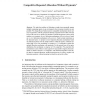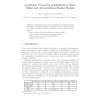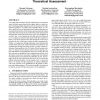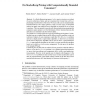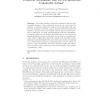106
click to vote
WINE
2009
Springer
15 years 7 months ago
2009
Springer
We study the problem of allocating a single item repeatedly among multiple competing agents, in an environment where monetary transfers are not possible. We design (Bayes-Nash) inc...
109
click to vote
WINE
2009
Springer
15 years 7 months ago
2009
Springer
We improve the best known competitive ratio (from 1/4 to 1/2), for the online multi-unit allocation problem, where the objective is to maximize the single-price revenue. Moreover, ...
WINE
2009
Springer
15 years 7 months ago
2009
Springer
We study the strategic behavior of risk-neutral non-myopic agents in Dynamic Parimutuel Markets (DPM). In a DPM, agents buy or sell shares of contracts, whose future payoff in a p...
108
click to vote
WINE
2009
Springer
15 years 7 months ago
2009
Springer
We study an economic setting in which a principal motivates a team of strategic agents to exert costly effort toward the success of a joint project. The action taken by each agent...
WINE
2009
Springer
15 years 7 months ago
2009
Springer
Following up on the work of Megiddo and Vazirani [10], who determined continuity properties of equilibrium prices and allocations for perhaps the simplest market model, Fisher’s ...
116
click to vote
WINE
2009
Springer
15 years 7 months ago
2009
Springer
It is widely believed that the value of acquiring a slot in a sponsored search list (that comes along with the organic links in a search engine’s result page) highly depends on ...
WINE
2009
Springer
15 years 7 months ago
2009
Springer
In a Stackelberg pricing game a leader aims to set prices on a subset of a given collection of items, such as to maximize her revenue from a follower purchasing a feasible subset o...
WINE
2009
Springer
15 years 7 months ago
2009
Springer
We study the problem of designing prediction markets for random variables with continuous or countably infinite outcomes on the real line. Our interval betting languages allow tra...
100
click to vote
WINE
2009
Springer
15 years 7 months ago
2009
Springer
Abstract. We are interested in mechanisms that maximize social welfare. In [2] this problem was studied for multi-unit auctions and for public project problems, and in each case so...
104
click to vote
WINE
2009
Springer
15 years 7 months ago
2009
Springer
A potential downside of prediction markets is that they may incentivize agents to take undesirable actions in the real world. For example, a prediction market for whether a terrori...
